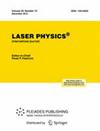Highly sensitive temperature sensor using nested hollow-core anti-resonant fibers
IF 1.1
4区 物理与天体物理
Q4 OPTICS
引用次数: 0
Abstract
A highly sensitive temperature sensor based on composite nested negative curvature hollow-core fiber is proposed. Three resonant tubes are nested inside the cladding tubes to induce a resonant coupling between the fundamental core mode and the dielectric mode of the nested resonant tube. Three glass-sheet conjoined nested tubes are introduced to suppress the comparatively low loss higher-order mode LP02. All the air-holes are filled with temperature-sensitive liquid of ethanol. As the temperature changes, the resonant dip in the transmission spectrum corresponding to the coupling will shift. Numerical simulation results indicate that the temperature sensitivity is 3.36 nm °C−1 in the range of 20 °C–40 °C. Since there is no need of any special post-processing, such as selective infiltration or material coating for the sensors proposed, the sensor provides a promising mechanism for the optical fiber temperature sensing.使用嵌套空芯抗谐振纤维的高灵敏温度传感器
本文提出了一种基于复合嵌套负曲率中空纤芯的高灵敏温度传感器。在包层管内嵌套了三个谐振管,以诱导基频纤芯模式与嵌套谐振管的介质模式之间的谐振耦合。还引入了三个玻璃片连接的嵌套管,以抑制损耗相对较低的高阶模式 LP02。所有气孔都充满了对温度敏感的乙醇液体。随着温度的变化,透射谱中与耦合相对应的共振倾角会发生移动。数值模拟结果表明,在 20 °C-40 °C 范围内,温度灵敏度为 3.36 nm °C-1。由于所提出的传感器不需要任何特殊的后处理,如选择性渗透或材料涂层,因此该传感器为光纤温度传感提供了一种前景广阔的机制。
本文章由计算机程序翻译,如有差异,请以英文原文为准。
求助全文
约1分钟内获得全文
求助全文
来源期刊

Laser Physics
物理-光学
CiteScore
2.60
自引率
8.30%
发文量
127
审稿时长
2.2 months
期刊介绍:
Laser Physics offers a comprehensive view of theoretical and experimental laser research and applications. Articles cover every aspect of modern laser physics and quantum electronics, emphasizing physical effects in various media (solid, gaseous, liquid) leading to the generation of laser radiation; peculiarities of propagation of laser radiation; problems involving impact of laser radiation on various substances and the emerging physical effects, including coherent ones; the applied use of lasers and laser spectroscopy; the processing and storage of information; and more.
The full list of subject areas covered is as follows:
-physics of lasers-
fibre optics and fibre lasers-
quantum optics and quantum information science-
ultrafast optics and strong-field physics-
nonlinear optics-
physics of cold trapped atoms-
laser methods in chemistry, biology, medicine and ecology-
laser spectroscopy-
novel laser materials and lasers-
optics of nanomaterials-
interaction of laser radiation with matter-
laser interaction with solids-
photonics
 求助内容:
求助内容: 应助结果提醒方式:
应助结果提醒方式:


